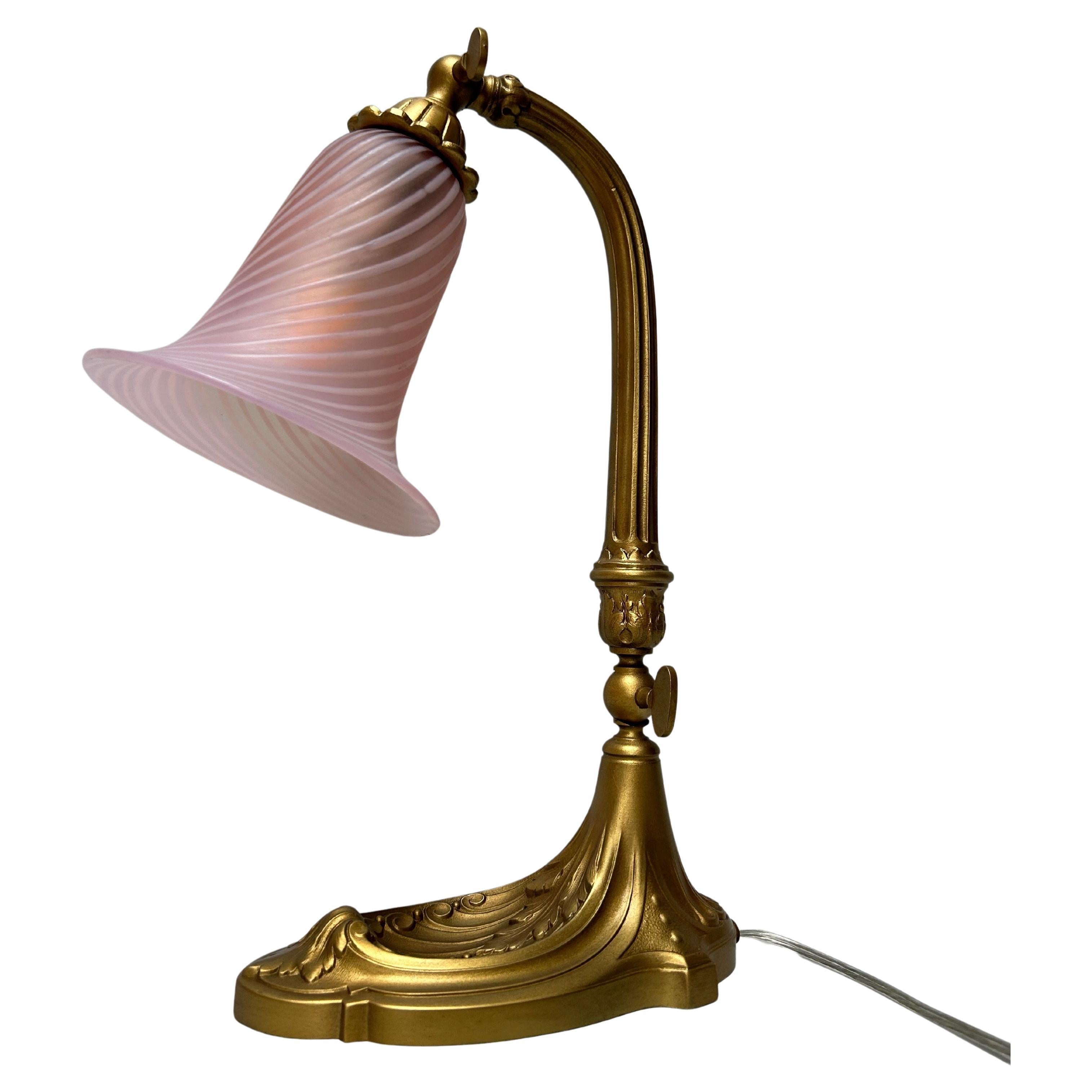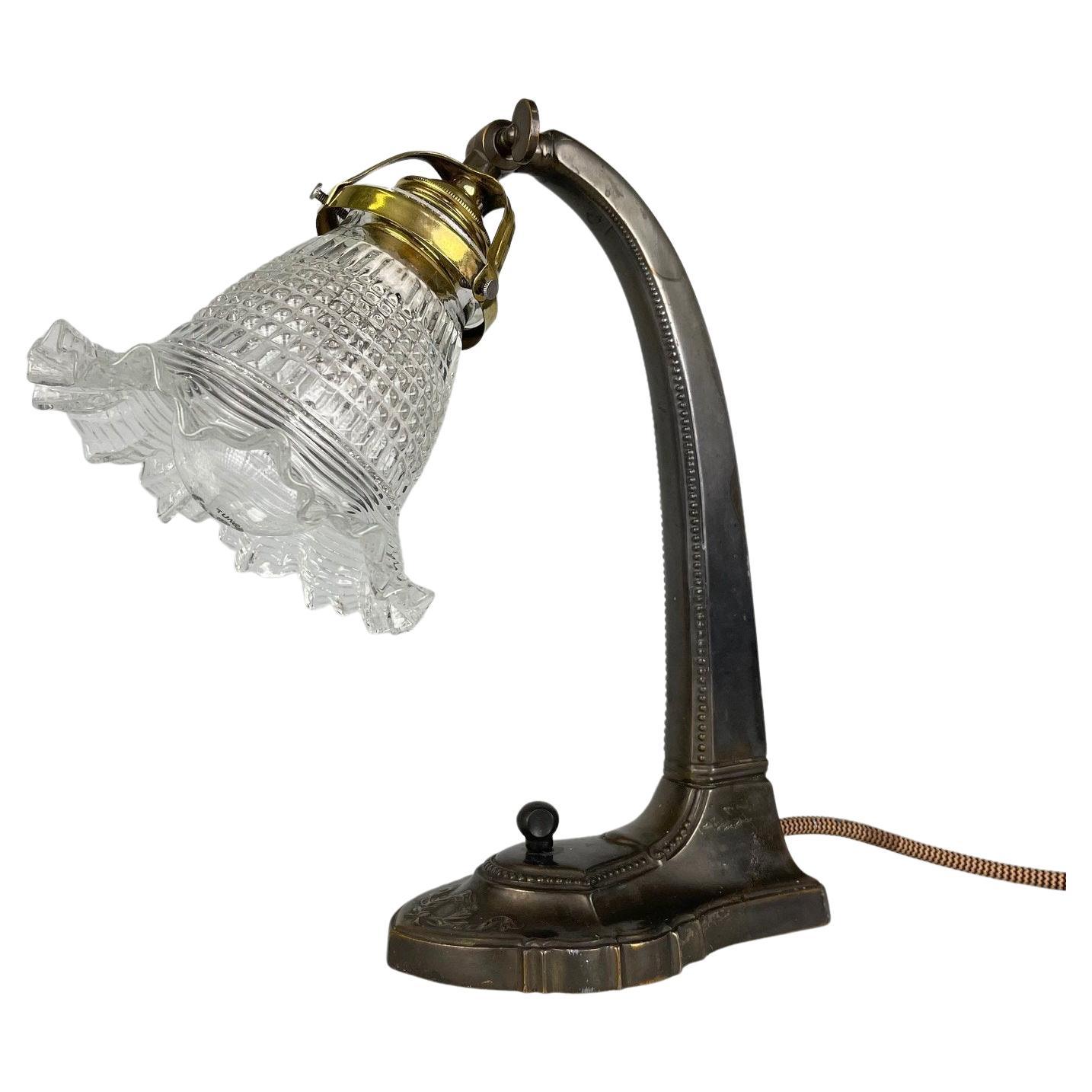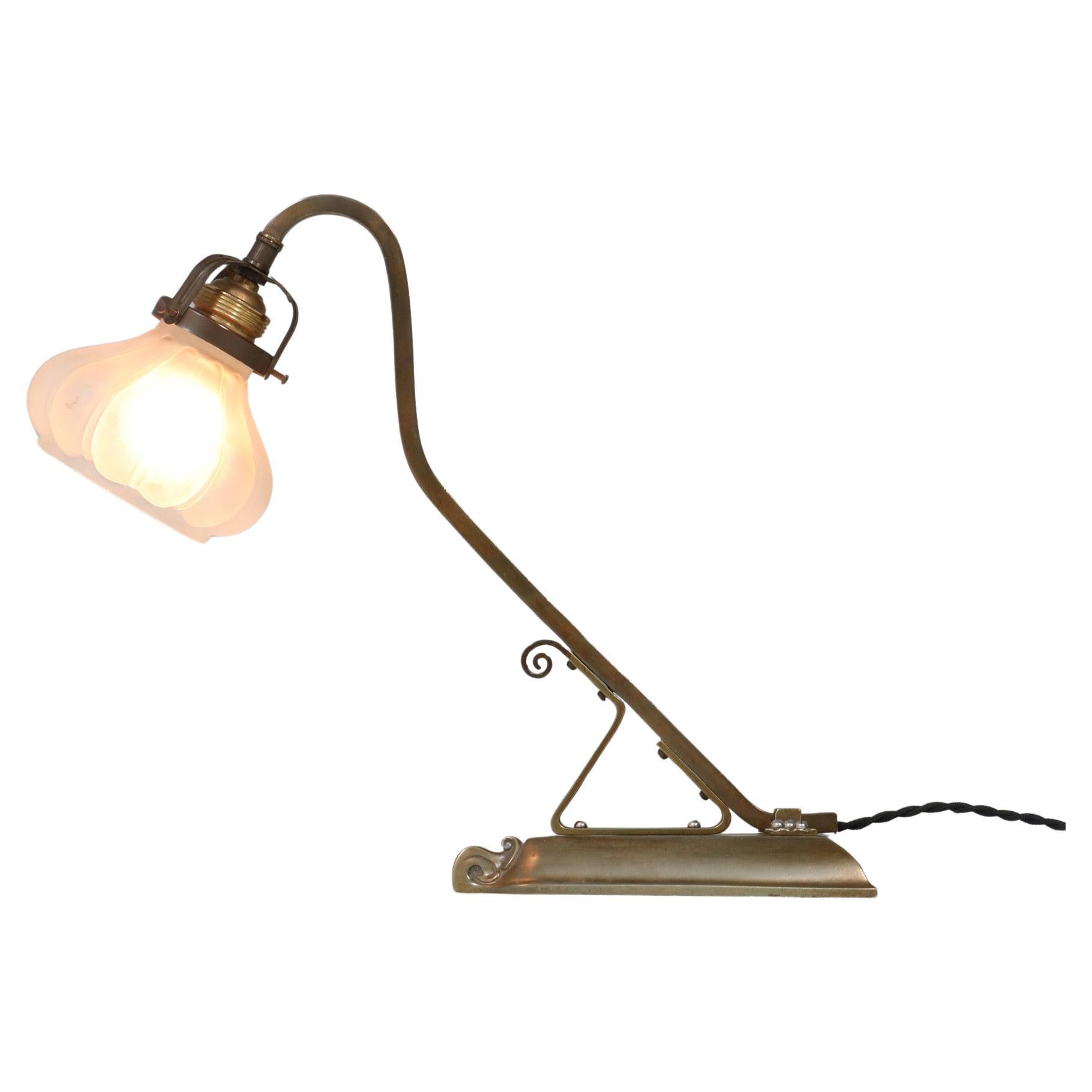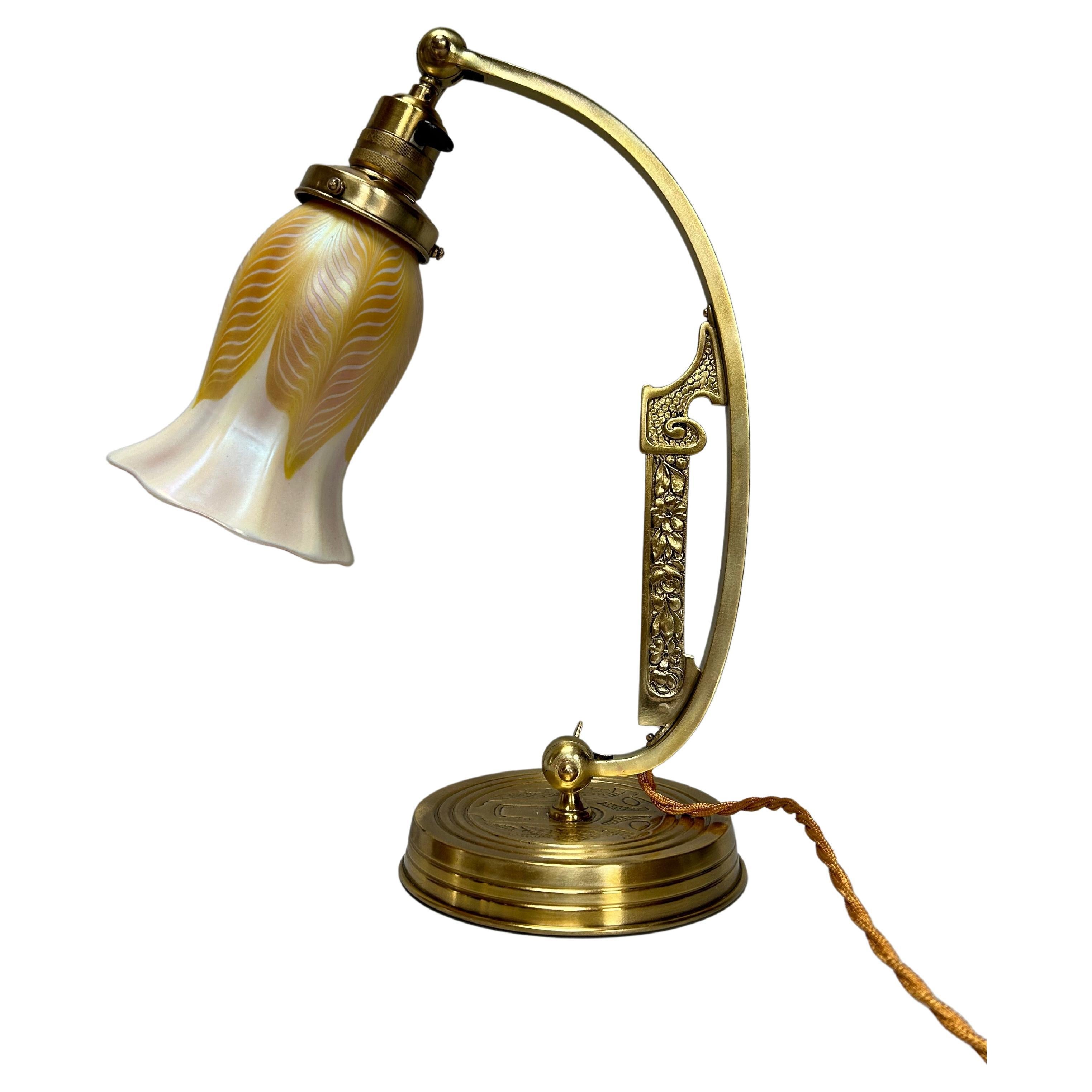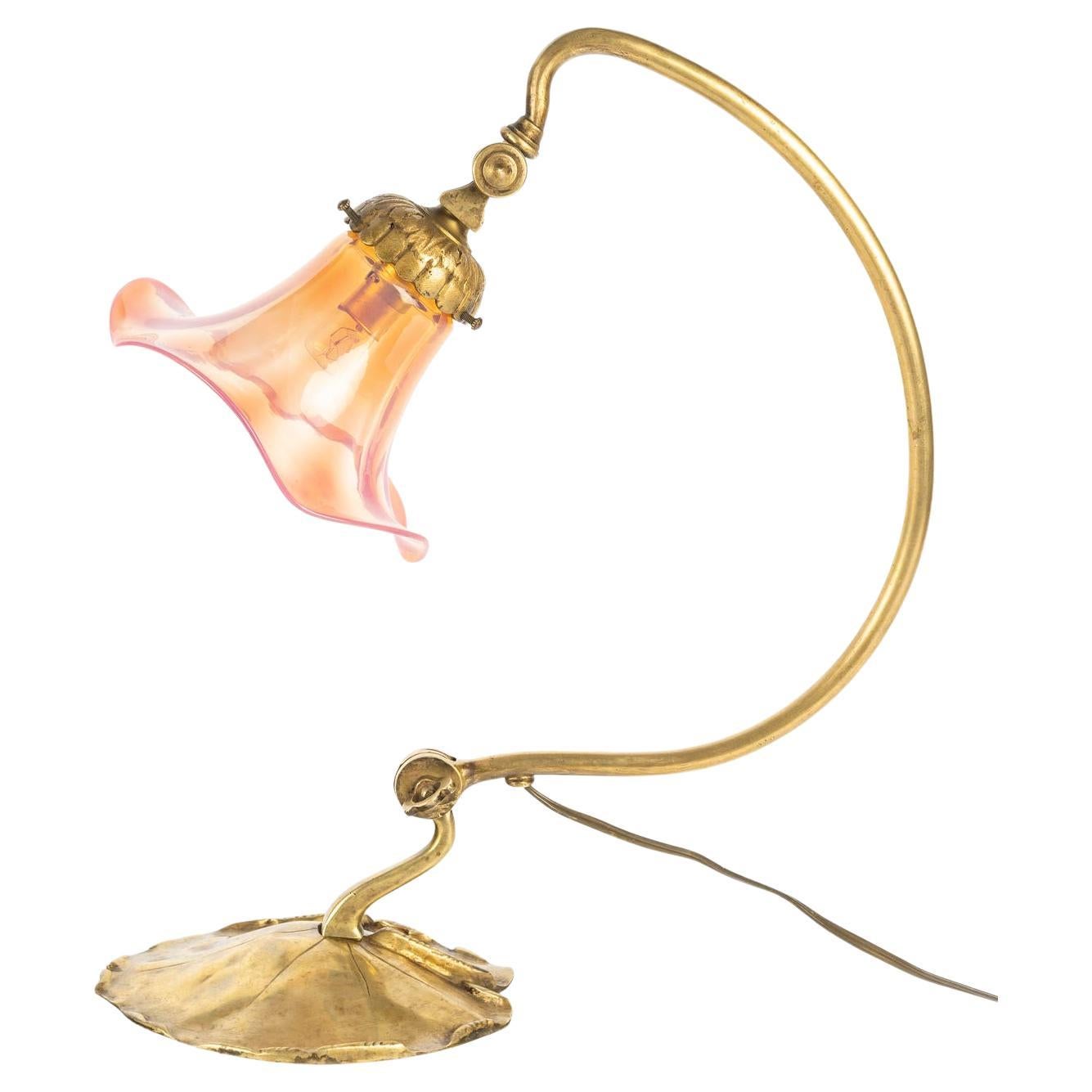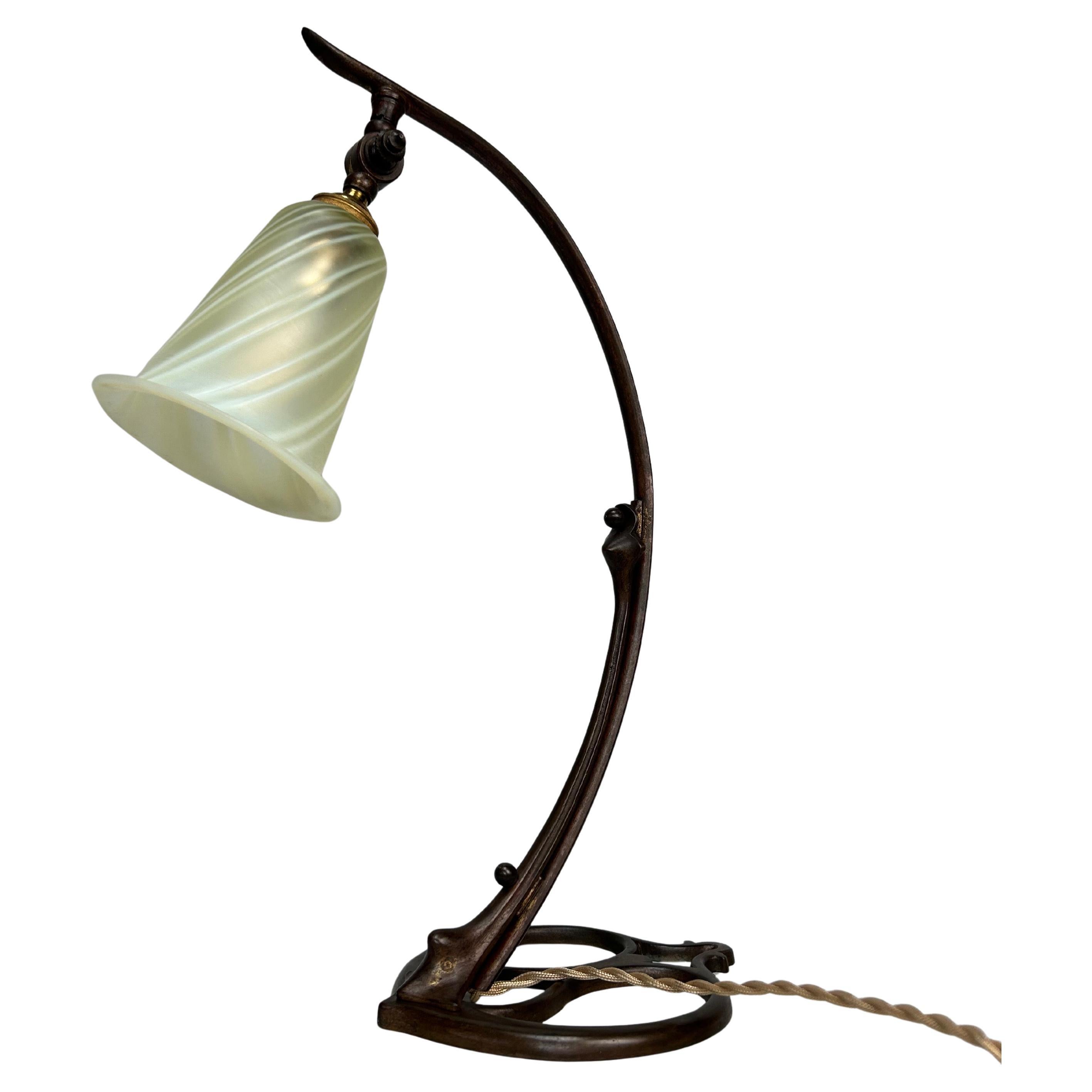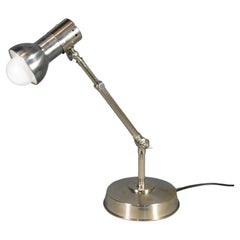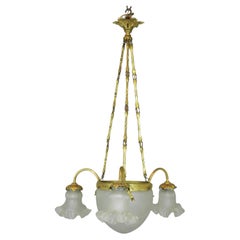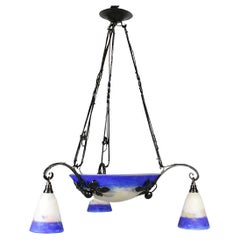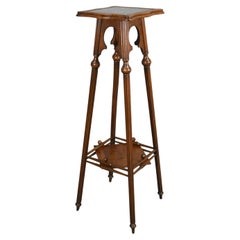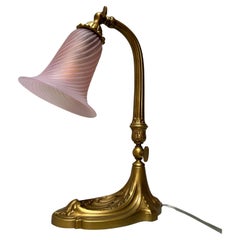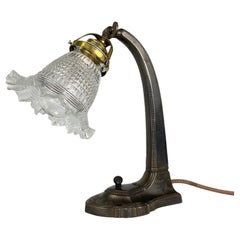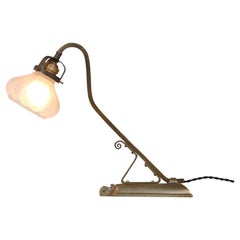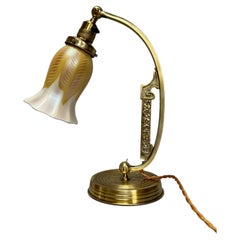Want more images or videos?
Request additional images or videos from the seller
1 of 16
French Art Nouveau Desk Lamp
$584.58
£439.34
€493
CA$818.68
A$897.84
CHF 465.02
MX$10,788.27
NOK 5,855.69
SEK 5,495.74
DKK 3,756.83
About the Item
French Art Nouveau Desk Lamp
A beautiful and elegant swan-shaped desk lamp, featuring flowers and leaves, which are classic motifs from the Art Nouveau period.
The gently curved neck / support holds a copper and brass lamp holder and a cage for the tulip frosted glass shade.
A thumb screw at the top enables adjustment of the bulb and shade.
The lamp is wired with a torpedo switch and a European plug. There is a ceramic on / off switch above the bulb. Supplied with screw-in E27 eco bulb.
The lamp has been tested and is in full working order. As with all electrical lighting we recommend having it tested by an approved electrician.
Both the stand and glass shade are in excellent condition. The main body has been repainted in a grey gloss finish.
Height: 30 cm
Width: 13 cm
Depth: 17 cm
Circa: 1900
- Dimensions:Height: 11.82 in (30 cm)Width: 5.12 in (13 cm)Depth: 6.7 in (17 cm)
- Power Source:Plug-in
- Voltage:220-240v
- Lampshade:Included
- Style:Art Nouveau (Of the Period)
- Materials and Techniques:
- Place of Origin:
- Period:
- Date of Manufacture:Circa: 1900
- Condition:Refinished.
- Seller Location:SAINTE-COLOMBE, FR
- Reference Number:Seller: 15341stDibs: LU6751237982882
About the Seller
5.0
Vetted Professional Seller
Every seller passes strict standards for authenticity and reliability
Established in 2014
1stDibs seller since 2022
15 sales on 1stDibs
Typical response time: 3 hours
- ShippingRetrieving quote...Shipping from: SAINTE-COLOMBE, France
- Return Policy
Authenticity Guarantee
In the unlikely event there’s an issue with an item’s authenticity, contact us within 1 year for a full refund. DetailsMoney-Back Guarantee
If your item is not as described, is damaged in transit, or does not arrive, contact us within 7 days for a full refund. Details24-Hour Cancellation
You have a 24-hour grace period in which to reconsider your purchase, with no questions asked.Vetted Professional Sellers
Our world-class sellers must adhere to strict standards for service and quality, maintaining the integrity of our listings.Price-Match Guarantee
If you find that a seller listed the same item for a lower price elsewhere, we’ll match it.Trusted Global Delivery
Our best-in-class carrier network provides specialized shipping options worldwide, including custom delivery.More From This Seller
View AllFrench Art Deco Anglepoise Desk Lamp in Chrome
Located in SAINTE-COLOMBE, FR
French Art Deco Anglepoise Desk Lamp in Chrome
A stylish and adjustable Art Deco Anglepoise Desk Lamp that can be angled into a wide variety of positions due to its three point adj...
Category
Early 20th Century French Art Deco Table Lamps
Materials
Aluminum, Chrome, Iron
French Three Arm Ceiling Light
Located in SAINTE-COLOMBE, FR
An impressive 1930s French three arm ceiling light with a frosted and cut glass bowl held within a brass retaining ring decorated with bows.
Issui...
Category
Vintage 1930s French Chandeliers and Pendants
Materials
Brass, Bronze
$609 Sale Price
63% Off
French Art Deco Ceiling Light Chandelier signed Degué
By Degué
Located in SAINTE-COLOMBE, FR
French Art Deco Four Light Ceiling Light signed Degué (David Gueron, 1892 - 1950)
A beautiful example of Art Deco design from the 1930s that is signed on the main bowl and all thre...
Category
Early 20th Century French Art Deco Chandeliers and Pendants
Materials
Wrought Iron
$2,276 Sale Price
20% Off
French Art Nouveau Sellette
Located in SAINTE-COLOMBE, FR
French Art Nouveau Sellette torchère stand
This elegant Art Nouveau sellette / stand has a striking architectural appearance and features an inset variegated grey marble top, set into a moulded wooden frame.
Made of beech wood the piece has splayed legs leading down to a raised shelf set...
Category
Vintage 1910s French Art Nouveau Side Tables
Materials
Marble
$978 Sale Price
25% Off
French Gilt Hall Lantern
Located in SAINTE-COLOMBE, FR
French Gilt Hall Lantern
This French Gilt Hall Lantern features a one-piece cut glass clear shade that is surrounded by decorative adorments with fi...
Category
Mid-20th Century French Mid-Century Modern Lanterns
Materials
Metal
$901 Sale Price
20% Off
Pair of French Mid-Century Cut Glass Table Lamps Empire Style
Located in SAINTE-COLOMBE, FR
Pair of French Mid-Century Cut Glass Table Lamps Empire Style
A matching pair of French Cut Glass Table Lamps with cascading rows of finely cut glass, elegantly forming the shape o...
Category
Mid-20th Century French Mid-Century Modern Table Lamps
Materials
Brass
You May Also Like
Art Nouveau Desk Lamp
Located in NANTES, FR
Desk lamp in gilded spelter circa 1910. Tulip tilt adjustment possible.
Tulip in opalescent glass.
Electrified, B22 socket.
in perfect condition.
Height: 34 cm
Width: 25 cm
Depth: 1...
Category
Early 20th Century French Art Nouveau Table Lamps
Materials
Spelter
$1,422
Art Nouveau Table Lamp, 1910's
Located in Praha, CZ
Beautiful antique Art Nouveau lamp made of copper alloy, patinated to old bronze. Produced in former Czechoslovakia in the very beginning of 2...
Category
Early 20th Century Czech Art Nouveau Table Lamps
Materials
Metal
Art Nouveau Table Lamp or Desk Lamp, 1900s
Located in Amsterdam, NL
Stunning and rare Art Nouveau table lamp or desk lamp.
Striking Dutch design from the 1900s.
Patinated brass frame with original hand-blown glass shade.
Rewired with one original soc...
Category
Antique Early 1900s Dutch Art Nouveau Table Lamps
Materials
Brass
$640 Sale Price
20% Off
Quezal Art Nouveau Lamp
By Quezal
Located in NANTES, FR
Art nouveau lamp circa 1910.
Brass and copper base.
Iridescent glass tulip signed Quezal.
In perfect condition and electrified.
Total height: 38.5 cm
Base diameter: 15.5 cm
Width: 30 cm
Quezal Art Glass
Quezal Art Glass – The Journal of Antiques and Collectibles – April 2003
By Malcolm Mac Neil
Some of the most beautiful and alluring art glass made in America during the early part of the 20th Century was made by the Quezal Art Glass and Decorating Company. Often in the shape of blossoming lilies with brilliant gold interiors and colorfully decorated with floral and other motifs inspired by nature, Quezal art glass ranks right alongside the iridescent glass of Louis Comfort Tiffany and Frederick Carder. Quezal artisans created an extensive range of decorative and useful items, including vases, compotes, finger bowls, open salts, candle holders, and shades for lighting fixtures, which are equivalent in terms of beauty and quality of craftsmanship to Tiffany’s Favrile and Carder’s Aurene glass. In recent years, glass collectors have discovered anew the special charms and appeal of Quezal art glass, and collector desirability for this lovely glassware has increased dramatically.
The Quezal Art Glass and Decorating Company was incorporated a century ago, on March 27, 1902. It was founded by Martin Bach, Sr., Thomas Johnson, Nicholas Bach, Lena Scholtz, and Adolph Demuth. The factory was located on the corner of Fresh Pond Road and Metropolitan Avenue in Maspeth, Queens, New York. In October 1902, the trademark “Quezal” was successfully registered. By 1904, roughly fifty glassworkers were employed at the works.
Martin Bach, Sr. was the president, proprietor, and guiding force behind this successful company. Born in 1862 in Alsace-Lorraine to German parents, he emigrated to the United States in 1891. Before his emigration, Bach worked in Saint-Louis, France, at the Saint-Louis Glass Factory. After Bach arrived in this country, he was hired by Louis C. Tiffany as the latter’s first batch-mixer or chemist at the newly established Tiffany Glass and Decorating Company, in Corona, Queens. After a period of about eight years, Bach left Tiffany and established his own glassworks. By this time, Bach had already started his small family. He and his German-born wife, Anne-Marie Geisser, whom he married in the fall of 1889, in Paris, France, had three children. Two daughters, Jennie and Louise, were born in France and a son, Martin, Jr., was born in Corona.
Bach was assisted by Thomas Johnson, an English immigrant, and Maurice Kelly, a native of Corona, both of whom were gaffers or master glassblowers. Johnson and Kelly helped pave the way for Quezal’s early accomplishments and later recognition. Thomas Johnson, like Bach, was a founding member and also previously employed by Louis C. Tiffany. Johnson’s association with Quezal, however, was relatively short lived. Around 1907, Johnson left for Somerville, Massachusetts, where he became involved in making Kew Blas glass, under William S. Blake at the Union Glass Company. Maurice Kelly’s tenure with Quezal was also brief. Kelly worked at Quezal from January 1902 until July 1904, but by November 1904, he was making Favrile glass at Tiffany Furnaces, where he would happily remain until 1918.
To this day, the belief still exists that there once existed a man named Quezal, who worked for Louis C. Tiffany, and it is after him that Quezal glass is named. In truth, however, the founders of the Quezal Art Glass and Decorating Company named the company and its products after one of the world’s most beautiful birds, the elusive and rare quetzal, which dwells in the treetops of the remote tropical forests of Central America. A rare company promotional brochure provides a vivid description of the quetzal: Of all the birds of the America’s, it is the most gorgeous. No more splendid sight is to be seen in all the world than a quezal, flying like a darting flame through the depths of a Central American forest. Its back is of a brilliant metallic green, so vivid it shines even in the twilight of the woods like a great emerald and its breast is a crimson so deep and bright that every motion of the wonderful creature is a flashing of rubies among the trees and giant creepers. It bears a true golden crown upon its head – a helmet of bright yellow and green, shaped just as the helmet of old Aztec kings were shaped. Its tail is composed of lacelike plumes, extending more than two and one-half feet beyond its body.
The quezal was certainly an appropriate designation for the company’s resplendent glassware. One of the most prized characteristics of Quezal art glass is the shimmering and dazzling brilliance reflected in the iridescent surfaces on the interior as well as exterior of the glass. The radiant rainbow colors in metallic hues, including gold, purple, blue, green, and pink, to name only a few, were certainly inspired by the quetzal and its feathers. Not surprisingly, lustrous feathers, in shades of opal, gold, emerald, and blue, are among the most common decorative motifs encountered on Quezal glass.
The enduring hallmark of Quezal art glass is its unique expression of the Art Nouveau style, based on organic shapes and naturalistic motifs coupled with technical perfection in the execution. Vases, compotes, drinking vessels, and shades for lighting fixtures were often fashioned to resemble flowers such as crocuses, tulips, calla lilies, casablanca lilies, and jack-in-the-pulpits. Variously colored inlaid threads of glass, pulled and twisted by hooks, simulate naturalistic floral and leaf patterns, lily pads, clover leafs, and vines. Opal, gold, and green colors prevail and the glass is generally opaque. Red is the rarest color of all. Compared with Tiffany’s Favrile glass, the crisp, vivid, and colorful decoration of Quezal art glass is distinctively precise, symmetrical, and restrained.
Other Quezal wares recall shapes and styles favored in ancient Egypt, Persia, Greece, and Rome, as well as the Italian Renaissance and the Georgian period in England. This is especially true of classic-shaped vases and bowls of translucent amber glass, which have a single surface color such as iridescent gold or blue. Still, others were inspired by traditional Chinese and Japanese forms.
The Gorham Manufacturing Company in Providence, Rhode Island, and the Alvin Silver Manufacturing Company in Sag Harbor, Long Island, purchased Quezal art glass, which they in turn embellished in their shops with silver overlay decoration in the fashionable Art Nouveau style and later resold. Gorham’s silver overlay designs mostly include stylized floral motifs. Alvin’s silver designs are wonderfully organic. One sumptuous design is of a group of sinuous iris blossoms with carefully articulated petals surrounded by attenuated meandering vines. Collectors should note that not all silver-deposit pieces are marked with a maker’s mark since the silversmith had to be quite careful not to damage the glass underneath.
A rare 1907 retail catalog survives from Bailey, Banks, and Biddle Company, a luxury goods retailer in Philadelphia, which reveals original retail prices of Quezal art glass. A surprising revelation provided by this catalog is that Quezal art glass was nearly twice as expensive as comparable French imported glass made by such renowned firms as Gallé and Daum. Hock glasses, a stemmed glass used primarily for drinking German white wine, were sold by the dozen and retailed between $50 and $75. Fingerbowls were also sold by the dozen and retailed between $50 and $100. These high retail prices were nearly the same as those charged for Tiffany’s Favrile glass, and suggest Quezal art glass was also marketed towards the high-end or luxury market.
Electricity was a brand new invention in the late 1800s and American glass manufacturers developed novel approaches for concealing the electric light bulb, which was rather harsh to the eye and perhaps unflattering to the domestic interior. Tiffany, Steuben, and Quezal responded to this need with the most extraordinary and beautiful art-glass shades, all of which were hand-made and exquisitely fashioned. Many other companies also made art glass shades for table and floor lamps, electroliers, hallway fixtures, and wall sconces, but it was Quezal that excelled in this area and was the most prolific.
Quezal art glass shades were available in an infinite variety of shapes, sizes, colors, and decorations. Some shades are formed and decorated as lilies while others are bell-shaped and have ribbed or textured decoration. Rims are usually plain but sometimes are notched or ruffled. Common motifs include feather or hooked feather, leaf and vine, applied flowers, drape, fishnet, King Tut, and spider webbing. The workmanship shown on most Quezal shades...
Category
Vintage 1910s French Art Nouveau Table Lamps
Materials
Brass, Copper
$3,320
Art Nouveau Bronze Lamp, circa 1900, Signed C.Berlier, Lyon.
Located in Saint-Ouen, FR
Art Nouveau bronze lamp, circa 1900, signed C.Berlier, Lyon.
Art Nouveau period lamp in bronze and pink transparent opaline glass by C.Berlier...
Category
20th Century French Art Nouveau Table Lamps
Materials
Bronze
Art Nouveau Lamp Base Model Hearts
Located in NANTES, FR
Art nouveau lamp circa 1910.
Bronze and brown patinated brass base, heart model.
Uraline tulip in opalescent glass.
The lamp is fully electrified and in ...
Category
Vintage 1910s French Art Nouveau Table Lamps
Materials
Brass, Bronze
More Ways To Browse
Antique Lamp Holders
Glass Top Swan Dining Tables
Art Nouveau Spelter Lamp
Figural Cherub Lamp
Frosted Lucite Lamp
Gio Ponti Bilia
Goose Lamp
Gravity Table Lamp
Hand Painted Bamboo Lamp
Herve Rousseau
Iron Oil Lamp
Japanese Cloisonne Lamps
Jug Table Lamp
Kaiser Leuchten Ceramic Table Lamp
Lamp With Painted Birds
Lavender Table Lamp
Machinist Lamp
Maiden Lamp
